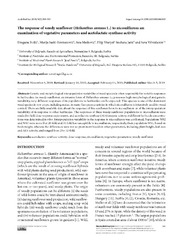Приказ основних података о документу
The response of weedy sunflower (Helianthus annuus L.) to nicosulfuron: An examination of vegetative parameters and acetolactate synthase activity
| dc.creator | Božić, Dragana | |
| dc.creator | Sarić-Krsmanović, Marija | |
| dc.creator | Matković, Ana | |
| dc.creator | Vranješ, Filip | |
| dc.creator | Jarić, Snežana | |
| dc.creator | Vrbničanin, Sava | |
| dc.date.accessioned | 2019-07-09T11:32:14Z | |
| dc.date.available | 2019-07-09T11:32:14Z | |
| dc.date.issued | 2019 | |
| dc.identifier.uri | http://www.doiserbia.nb.rs/Article.aspx?ID=0354-46641900012B | |
| dc.identifier.uri | http://www.serbiosoc.org.rs/arch/index.php/abs/article/view/3607 | |
| dc.identifier.uri | https://radar.ibiss.bg.ac.rs/handle/123456789/3398 | |
| dc.description.abstract | Genetic and morphological interpopulation variability of weed species is often responsible for variable responses to herbicides. As weedy sunflower, an invasive form of Helianthus annuus L., possesses high morphological and genetic variability, very different responses of its populations to herbicides can be expected. This species is one of the dominant weed species in row crops, including maize, in many European countries in which nicosulfuron is intensively used for weed control. There are little available data about the response of this sunflower form to nicosulfuron or of the interpopulation variability of its response to other herbicides. The responses of three weedy sunflower populations to nicosulfuron were studied in field dose-response experiments, and acetolactate synthase (ALS) enzyme activity at different herbicide concentrations was determined in vitro. Interpopulation variability in the response to nicosulfuron was confirmed. Populations WS2 and WS3 were more that 20-fold and 30-fold less susceptible to nicosulfuron, respectively, than population WS1, based on fresh weight, whereas the differences were not so prominent based on other parameters, including plant height, leaf area and ALS activity, and ranged from 2 to 12-fold. | en |
| dc.relation | info:eu-repo/grantAgreement/MESTD/Integrated and Interdisciplinary Research (IIR or III)/46008/RS// | |
| dc.relation | info:eu-repo/grantAgreement/MESTD/Basic Research (BR or ON)/173018/RS// | |
| dc.rights | openAccess | |
| dc.rights.uri | https://creativecommons.org/licenses/by-nc-nd/4.0/ | |
| dc.source | Archives of Biological Sciences | |
| dc.subject | Acetolactate synthase activity | |
| dc.subject | Dose-response | |
| dc.subject | Nicosulfuron | |
| dc.subject | Vegetative parameters | |
| dc.subject | Weedy sunflower | |
| dc.title | The response of weedy sunflower (Helianthus annuus L.) to nicosulfuron: An examination of vegetative parameters and acetolactate synthase activity | en |
| dc.type | article | en |
| dc.rights.license | BY-NC-ND | |
| dcterms.abstract | Врбничанин, Сава; Врањеш, Филип; Матковић, Aна; Божић, Драгана; Сарић-Крсмановић, Марија; Јарић, Снежана; | |
| dc.rights.holder | © 2019 by the Serbian Biological Society. | |
| dc.citation.issue | 2 | |
| dc.citation.volume | 71 | |
| dc.identifier.doi | 10.2298/ABS181106012B | |
| dc.identifier.scopus | 2-s2.0-85067116662 | |
| dc.identifier.wos | 000471069700012 | |
| dc.citation.apa | Božić, D., Sarić-Krsmanović, M., Matković, A., Vranješ, F., Jarić, S., & Vrbničanin, S. (2019). The response of weedy sunflower (Helianthus annuus L.) to nicosulfuron: An examination of vegetative parameters and acetolactate synthase activity. Archives of Biological Sciences, 71(2), 305–313. | |
| dc.citation.vancouver | Božić D, Sarić-Krsmanović M, Matković A, Vranješ F, Jarić S, Vrbničanin S. The response of weedy sunflower (Helianthus annuus L.) to nicosulfuron: An examination of vegetative parameters and acetolactate synthase activity. Arch Biol Sci. 2019;71(2):305–13. | |
| dc.citation.spage | 305 | |
| dc.citation.epage | 313 | |
| dc.type.version | publishedVersion | |
| dc.identifier.fulltext | https://radar.ibiss.bg.ac.rs//bitstream/id/5157/ABS-71-2-305-313.pdf | |
| dc.citation.rank | M23 |

